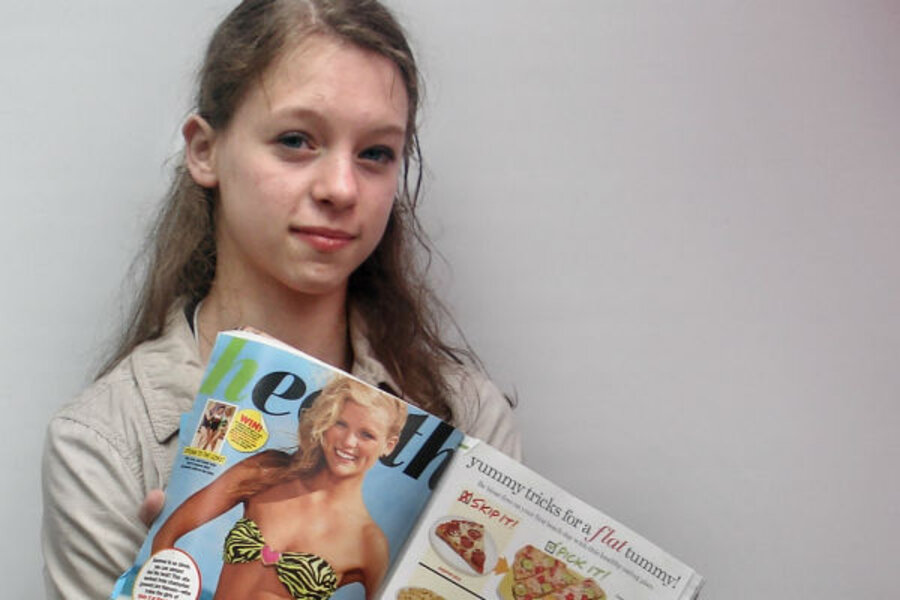Seventeen magazine promises to stop manipulating photos of models
Loading...
| New York
Score one for girl power.
A 14-year-old Maine ballet dancer who led a crusade against altered photos in Seventeen magazine now has a promise from top editor Ann Shoket to leave body shapes alone, reserving Photoshop for the stray hair, clothing wrinkle, errant bra strap or zit.
And when Ms. Shoket or her staff do manipulate images, she vowed in the August issue, they'll post before and after shots on the magazine's Tumblr page for full transparency.
Shoket's promises are included in a "body peace treaty" that also commits the magazine to always feature healthy girls and models regardless of clothing size.
The young activist, Julia Bluhm, said Friday from her summer camp she's "really excited."
"I didn't think it would get this big," she said. "It's a really great surprise for me."
Julia and her mom, Mary Beiter, sat down with Shoket in New York in early May to discuss the thousands of signatures on the Waterville girl's online petition at Change.org. Julia declared victory after Shoket's announcement, ending with more than 84,000 signatures.
Now, two of her fellow bloggers from SPARK Summit, a group of girls and young women trying to end the sexualization of girls in the media, are targeting Teen Vogue to make the same commitment. They've collected more than 15,000 signatures since Tuesday.
Shoket did not identify Julia by name in her full-page declaration, which also denied the magazine ever changed the shapes of bodies and faces. She had no further comment Friday.
The editor did cite the support of the National Eating Disorders Association. The group's president, Lynn Grefe, lauded the effort as a first step but said far more must be done to promote positive body image and a more attainable standard of health and beauty in magazines and other media.
"I'm not saying it's a total victory," Ms. Grefe said. "Seventeen, Teen Vogue, Vogue, Cosmo, every magazine still has ads for diet products and other things that we find problematic, but in terms of the Photoshopping stuff, I believe that Ann is sincere and wants to really educate the consumer and work with the girls and show them what has been Photoshopped and how to recognize that."
Julia's mother also was pleased but agreed: "Certainly there's probably more that they could do, but these things probably come in stages, and something is something. Something is good. It opens the door. That's always the biggest hurdle."
Julia had asked Seventeen to run at least one unaltered photo spread a month, saying Seventeen and other magazines put pressure on girls to emulate perfect-looking models without realizing images have been doctored. Manipulated images, Grefe said, contribute to eating disorders, depression and low self-esteem among girls as young as 8.
Grefe noted that 40 percent of newly identified cases of anorexia are in girls and young women 15 to 19 years old. She cited research showing more than half of teen girls and nearly one-third of teen boys use unhealthy weight control behaviors, such as skipping meals, fasting, smoking cigarettes, vomiting and taking laxatives.
Girls who diet frequently are 12 times as likely to binge as girls who don't diet, Grefe said, noting that most fashion models are thinner than 98 percent of American women.
Izzy Labbe, a 13-year-old from Waterville who collaborated with Julia on the Seventeen petition, was thrilled at Shoket's response but agreed she could have gone further.
"The measures they're taking are fabulous, don't get me wrong, but I feel like they never admitted to doing anything wrong," Izzy said.
Audrey Brashich, a former teen model and editor of the now-defunct teen magazine YM, said the Seventeen pledge has far more potential for immediate, tangible changes in the minds of girls than a vow from Vogue editors around the world to ban models under 16 or those of any age with visible signs of eating disorders.
Vogue didn't address the widespread industry practice of digitally altering photos when it made the promise in May.
Ms. Brashich, who in 2006 published a book called "All Made Up: A Girl's Guide to Seeing Through Celebrity Hype and Celebrating Real Beauty," said she hopes Seventeen lives up to its promise.
"And if the magazine doesn't do all that," she said, "I hope Julia Bluhm and her 84,000 supporters are right there to point out its failures."







